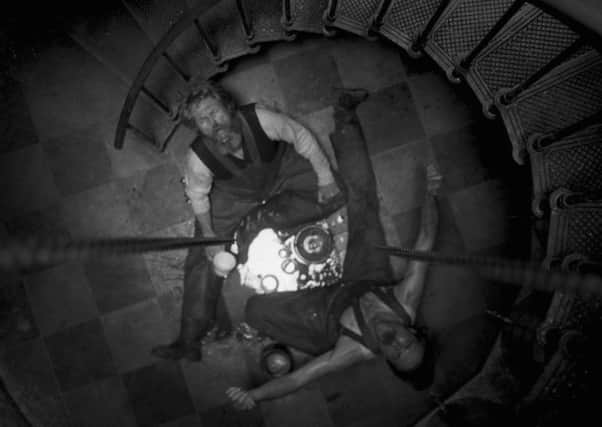Film reviews: The Lighthouse | A Beautiful Day in the Neighbourhood | Queen & Slim | The Man Who Killed Don Quixote


The Lighthouse (18) ****
A Beautiful Day in the Neighbourhood (PG) ***
Queen & Slim (15) ***
The Man Who Killed Don Quixote (15) ***
Filmmaker Robert Eggers makes good on the promise of his unexpected 2015 box-office hit The Witch with new film The Lighthouse, a thoroughly out-there follow-up that’s even more twisted and artistically audacious. Shot in stark black-and-white and framed using boxy academy ratio, it’s a deranged tale of madness, malevolence and mermaid-themed masturbation, set in the isolated confines of a lighthouse off the coast of 1890s Maine, and featuring committed performances from Willem Dafoe as the titular structure’s flatulent, unhinged, secret-bearing keeper, and Robert Pattinson as his latest underling, a man of far fewer words but no more in charge of his own faculties.
Eggers establishes his protagonists’ tenuous grip on reality in the opening scenes by having them stare down the lens of the camera as if daring us to keep watching – and he sets the off-kilter tone with the industrial foghorn blast of a ship, a motif that functions as a near-constant harbinger of doom and, quite possibly, a manifestation of what’s going on in the heads of both men. No other living human beings feature, but there are appearances from severed heads, ghostly apparitions, barnacle-encrusted sea creatures and a fishy siren that fuels the fantasies of Pattinson’s drifter, providing onanistic relief from his more violent altercations with the island’s seabird population.
Advertisement
Hide AdThis is a film steeped in folkloric tradition; it’s also steeped in the salty linguistic constructions and myth-making of Herman Melville, the latter manifesting itself in the breakdown of Dafoe and Pattinson’s toxic relationship as the younger man’s fascination with the lighthouse lamp that Dafoe’s character worships intensifies their mutual wariness and paranoia. Quite how seriously we’re supposed to take all this is up for debate; like Jack Nicholson’s Grand Guignol performance in The Shining and much of David Lynch’s wilfully surreal horror inflections, there’s a dark strain of humour running throughout. The good news is that Eggers has absolute control over it. The end result is horrific and hilarious – and all the better for it.
A lack of familiarity with American children’s TV entertainer Mr Rogers might be a sticking point in your appreciation of A Beautiful Day in the Neighbourhood, which takes a sideways glance at Fred Rogers (played by Tom Hanks) via the fictionalised story of a troubled magazine journalist (Matthew Rhys) sent to interview him. The broad strokes of the story here are true: Rogers really was interviewed in the late 1990s by Esquire journalist Tom Junod, whose hard-hitting reputation for saying the unsayable made him an unlikely choice to profile such a beloved entertainer. But for the movie’s purposes, Junod has become Lloyd Vogel, an investigative reporter whose unprocessed rage towards his philandering father (Chris Cooper) is exacerbated by his own insecurities about recently becoming a dad.
Off-the-peg backstory established, the film, directed by Can You Ever Forgive Me’s Marielle Heller, trusts that Vogel’s inevitable redemption will be a useful way into Rogers’ story. But if that sounds uninspired, the film works hard to find subtle ways to mine drama from the tension between Vogel’s professional cynicism and the seemingly saintly way Rogers conducts his life. Can he possibly be for real? Heller pulls at this thread with real delicacy and with Hanks (Oscar-nominated for best supporting actor) she’s able to capitalise on her star’s own national treasure status to carefully examine the effort it takes Rogers to maintain the sort of composure in all facets of his life that he demonstrates with pre-schoolers on his morally instructive television show, Mr Rogers’ Neighbourhood.
Here, Heller does a lovely job of utilising the style and aesthetics of the show to provide psychological insights into her protagonists, so even though Lloyd’s story can feel a little one-note, Hanks’s nuanced interpretation of Rogers captures well the complexities and struggles involved in being a genuinely nice guy.
In the brilliant opening of Queen & Slim, a young black couple on a first date that’s going nowhere find their lives suddenly yoked together after a violent altercation with a racist cop. In an instant these never-named strangers – played by Get Out’s Daniel Kaluuya and relative newcomer Jodie Turner-Smith – see their options narrowing and debut feature director Melina Matsoukas and screenwriter Lena Waithe ratchet up the tension in swift, urgent fashion. Seeing no choice but to become outlaws in a country in which the criminal justice system is rigged against people of colour, these hitherto ordinary citizens are forced to embark on an impromptu cross-country odyssey to find a safe haven.
Unfortunately, it’s here that the film starts falling apart. Episodic plotting, clichéd supporting characters and ill-judged stylistic choices chip away at the integrity of the opening, though Kaluuya and Turner-Smith remain engaging throughout.
Advertisement
Hide AdThirty years in the making (and unmaking), Terry Gilliam’s The Man Who Killed Don Quixote is as over-the-top and messy as its tortured production history suggests. Adam Driver takes the lead as Toby, a disillusioned commercials director who goes on a strange meta journey into his past when he reconnects with the Spanish cobbler (Jonathan Pryce) he once cast in a short film inspired by Cervantes’ ground-breaking novel. Discovering the experience has caused this man to believe he’s the real Quixote, Toby gradually finds himself slipping into the role of Quixote’s sidekick, Sancho Panza, with the ensuing adventure re-awakening his own lust for life. The end result is fun and frustrating in almost equal measure. ■